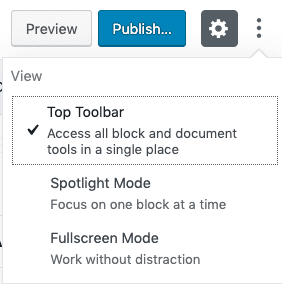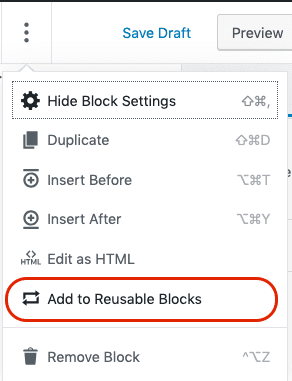As you get used to using the new Gutenberg block editor, you will notice that there are some handy shortcuts. We will gather some of the tips we’ve noticed to help you get the most out of Gutenberg.
Top Toolbar
By default, Gutenberg has the toolbar for each block at the top of each block. If you find this gets in the way or want one place to look for it, you can choose Top Toolbar from the View settings.
- Click the three-dot menu at the top right of the screen.
- Select Top Toolbar
- The Toolbar for each block will now stick to the top of the screen, keeping it in one place and out of your way.

New Blocks Shortcut
When adding a new block, you can use the forward slash ( / ) keystroke to bring up a dialog box listing all of the available blocks. The most recent ones will be displayed, but you can also start typing the name. As you become more familiar with the different blocks, this will be a quick way to choose the block you want to use.


Reusable Blocks
If you create a block that you want to use again, you can make it reusable. You can then reuse the block in other pages and posts.
- Create the block you want to reuse.
- Click the three-dot menu in the toolbar and select “Add to Reusable Blocks”.
- Give it a descriptive title so you can identify it quickly.

To use the block later, simply choose it from the available blocks. You can make any changes by clicking the Edit button. However, any changes will be made to the block on any page or post it is being used. You can convert it to a regular block, by clicking the three-dot menu item and choosing “Convert to Regular Block”.
Converting from Classic
If your site was created using the Classic editor, you may find that when editing your pages in Gutenberg that all of the content is in one big Classic block. To make full use of Gutenberg, you can convert this one big Classic block into individual blocks.

- Edit your existing page.
- Click on the Classic block heading to show the 3 dots in the right corner to open the More Options settings. (If you are using the Top Toolbar the 3 dots will be at the top of the page.)
- Select Convert to Blocks
- Your page will now be converted to the appropriate blocks with the available settings for each block type.
Gutenberg Tools
At the top of the editing page, you will see a set of tools including:

- Add Block (+) – This lets you easily add a new block.
- Undo ( back arrow) – This lets you undo your last changes.
- Redo ( forward arrow) – This lets you redo the change you undid.
- Block navigation (outline) – This lets you see the structure of your page in blocks. This is particularly handy if you are using a layout item like columns and need to get to the column settings.
